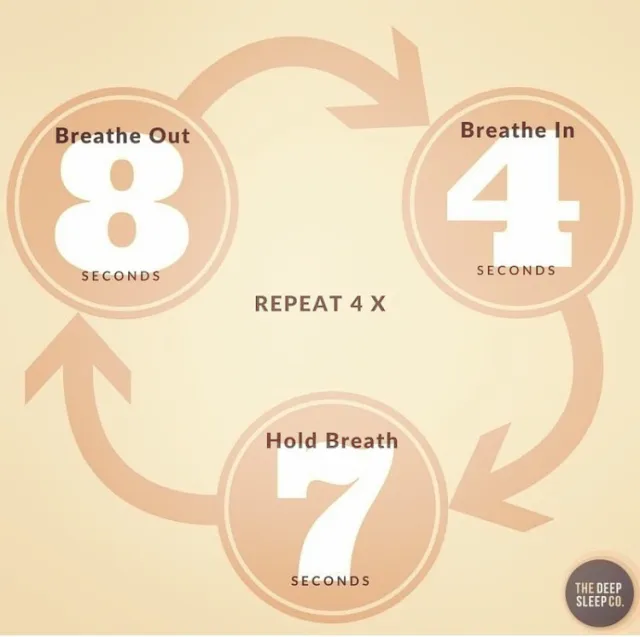Waking up in the middle of the night can be frustrating, especially when your mind immediately becomes alert and sleep feels impossible. Whether you’re staring at the ceiling at 3 AM or tossing and turning for what feels like hours, getting back to sleep doesn’t have to be a struggle. If you’re wondering how to go back to sleep quickly, these six simple tricks can help you drift off again, so you can wake up feeling refreshed instead of exhausted.
Don’t Check the Clock
It’s the first thing most of us do: we roll over and squint at the clock. 3:17 AM. The immediate mental math begins. “If I fall asleep right now, I’ll only get three more hours.” This single action can trigger a wave of sleep anxiety.
Suddenly, there’s pressure. You’re no longer just resting; you’re on a deadline to fall back asleep. This creates a stress response, releasing hormones like adrenaline and cortisol that are the complete opposite of what your body needs for sleep. My best advice? Turn your clock around before you even get into bed. If you use your phone, place it face down and out of reach. Resisting the urge to check the time removes the pressure and allows your body to relax naturally without a performance review.
Try the 4-7-8 Breathing Technique
When your mind is racing, your breath is usually shallow and quick. You can manually shift your body into a state of calm by controlling your breath. The 4-7-8 breathing technique is incredibly effective for this. It’s a simple practice rooted in pranayama, an ancient yogic method of breath regulation, and it helps activate your body’s relaxation response.

Here’s how you do it:
- Place the tip of your tongue against the ridge of tissue just behind your upper front teeth.
- Exhale completely through your mouth, making a whoosh sound.
- Close your mouth and inhale quietly through your nose for a mental count of four.
- Hold your breath for a count of seven.
- Exhale completely through your mouth, making that whoosh sound again, for a count of eight.
Repeat this cycle three or four times. The focus on counting and the long exhale physically slows your heart rate and quiets your nervous system, making it much easier to drift off.
Get Out of Bed After 15-20 Minutes
This might sound counterintuitive, but if you’ve been lying awake for what feels like more than 15 or 20 minutes, get out of bed. This is a core principle of stimulus control, a method for treating insomnia. The goal is to strengthen the mental association between your bed and sleep, not your bed and frustrated wakefulness.
Go to another room and do something quiet and calming in very low light. Read a physical book (not on a screen!), listen to soft music, or do some gentle stretches. Avoid anything stimulating. Once you start to feel sleepy again, head back to bed. This technique is a cornerstone of learning how to fall asleep fast in general, as it retrains your brain over time.
Keep Screens and Blue Light Away
I know it’s tempting to grab your phone and start scrolling when you can’t sleep. But this is one of the worst things you can do. The blue light emitted from phones, tablets, and TVs is a powerful signal to your brain that it’s daytime.

This light suppresses the production of melatonin, the hormone that regulates your sleep-wake cycle. Scrolling through social media or reading the news also engages your mind, making it more alert and anxious. Instead, make a firm rule: no screens when you wake up at night. If you need a distraction, stick to the analog activities mentioned above.
Use Body Scan Meditation or Progressive Muscle Relaxation
Often, it’s not just a racing mind keeping you awake but also physical tension you might not even be aware of. Two great techniques to address this are the body scan and progressive muscle relaxation.
For a body scan, lie comfortably and bring your attention to your toes. Notice any sensations—warmth, coolness, tingling—without judgment. Slowly move your focus up your body: to your feet, ankles, calves, and so on, all the way to the top of your head. This practice gently pulls your focus away from anxious thoughts and onto physical sensations, which is deeply relaxing.
For progressive muscle relaxation, you’ll systematically tense and then release different muscle groups. For instance, curl your toes tightly for five seconds, then release the tension completely for ten seconds. Move up to your calves, thighs, hands, and arms. This process makes you aware of where you hold tension and helps your body release it fully.
Adjust Your Sleep Environment
Sometimes the reason you wake up and can’t get back to sleep is simple: you’re uncomfortable. Your body’s core temperature needs to drop slightly to initiate and maintain sleep. If your room is too hot or too cold, it can easily disrupt your sleep cycle.

If you feel too warm, try opening a window, turning on a fan, or even placing a cool, damp cloth on your forehead. If you’re cold, grab an extra blanket or use a hot water bottle near your feet. Pay attention to your pajamas and bedding, too. Breathable fabrics like cotton or linen are much better for temperature regulation than synthetic ones. A comfortable, cool, dark, and quiet environment is the foundation of good sleep hygiene.
Conclusion
Waking up at night doesn’t have to ruin your next day. Instead of fighting the frustration, try approaching it with a calm strategy. By avoiding the clock, using your breath as a tool, resetting when needed, and ensuring your environment is comfortable, you can guide your body and mind back to rest.
Remember that an occasional bad night is normal. The key is not to let it become a source of stress. For more insights into creating healthy sleep habits, feel free to explore the resources at www.notonetype.org


You may also like this
How to Go Back to Sleep After a Nightmare: 7 Proven Techniques That Work
Waking up in a cold sweat, heart pounding against your ribs, is a jarring way...
Nov
How to Go Back to Sleep: Simple Techniques That Actually Work
Waking up in the middle of the night and struggling to fall back asleep is...
Nov
How Long Should It Take to Fall Asleep? Understanding Normal Sleep Latency
If you’ve ever laid in bed wondering whether you’re taking too long to drift off—or...
Nov
How to Sleep Fast in 2 Minutes: Military Method & Proven Tips
Struggling to fall asleep is something most of us have dealt with. You lie in...
Nov
How to Fall Asleep Fast: 12 Techniques That Work in Minutes
Tossing and turning at night is frustrating, especially when you’re exhausted but your mind won’t...
Nov
How to Sleep Early: Practical Steps to Shift Your Bedtime
Struggling to fall asleep early? You’re not alone. For years, I was a night owl,...
Nov